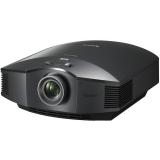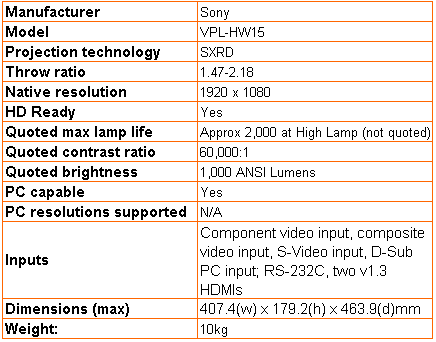Sony Bravia VPL-HW15 – SXRD Full HD Projector Review
Sony Bravia VPL-HW15 – SXRD Full HD Projector
Sony doubles the claimed contrast ratio on this updated SXRD home cinema projector.

Verdict
Key Specifications
- Review Price: £1995.00
For some reason, the run up to Christmas looks like being the most prolific season of projector releases ever. We’ve already recently looked at new offerings from Epson (Epson EH-TW5500) and Vivitek (Vivitek H1080FD), while also piled up in our offices right now are two new projectors from Sony, one from BenQ, one from Optoma and one from Acer. Plus there are imminent new models from JVC and a whole slew of other Epsons all due to roll our way in the coming weeks.
Sitting at the very top of our projector ‘to do’ pile, though, and so finding itself in the firing line today, happens to be Sony’s VPL-HW15 – a happy coincidence, actually, for oddly enough this is one of the new projectors that I’m most intrigued by.![]()
Why my interest? First, it’s the first new projector for a surprisingly long time to showcase Sony’s proprietary LCOS-inspired SXRD technology. Second, while the model it succeeds, the HW10, was a very good projector for its money, the HW15 usurps it with a claimed contrast ratio of 60,000:1 that’s double the HW10’s contrast figure.
Finally, on a more negative note, I have to say that part of my interest in the HW15 is inspired by the way the HW10 has been rather humbled in recent times during one or two head to head comparisons with new projectors from other brands – most notably Epson. In other words, it will be interesting to see if the HW15 manages to keep up with the new LCD and DLP Joneses when it comes to colour tones and dynamics.![]()
Let’s start, though, with a quick look at the HW15’s styling. As with all SXRD projectors to date, it’s actually a very attractive thing in its curvaceous shape and glossy finish.
It’s a quite large and heavy beast too, hinting at some surprisingly good build quality for such a reasonably priced projector, and suggesting that it’s definitely aimed at real movie fans, rather than being some casual device intended to be forever taken in and out of cupboards for occasional gaming or sporting event nights. It perhaps feels a touch lazy on Sony’s part that the HW15 actually looks absolutely identical to the HW10, but they could argue that as the previous design wasn’t broken, there was no need to fix it!
Tucked down the HW15’s side is a respectable strip of connections, including two HDMIs, a component video input, a PC VGA port, an S-Video input, a composite video input, and an RS-232 command/control port. It might have been nice if Sony could have run to a 12V trigger output and/or a USB port given its mid-range price point, but there you go.
Setting the HW15 up is really exceptionally easy for what is in some ways a quite sophisticated bit of kit. Particularly welcome are simple wheel adjusters on the projector’s top edge for shifting the image vertically or horizontally over quite a wide range, meaning that hardly anyone should find themselves having to distort the image via the projector’s keystone adjustment.![]()
Zoom and focus, meanwhile, are adjusted by pleasingly responsive rings around the lens. Its 1.6:1 zoom ratio and short-throw design should enable everyone but people with very long rooms to fit an image precisely to their screen, without having to compromise on projector positioning.
Some couch potatoes might take issue with the fact that the HW15 only lets you adjust its zoom and focus via the manual lens rings, rather than letting you do it via the remote. But so far as I’m concerned, if not having a motorised zoom and focus has helped Sony sneak below two grand with the HW15, then it’s a compromise I’m more than happy to make.
Heading into the HW15’s menus, they’re not particularly spectacular to look at, but efficient enough at what they do. Plus they contain a few points of interest. Immediately obvious are three reasonably sensible Sony picture preset options (Dynamic, Standard and Cinema), as well as memory slots for a further three setting systems conjured up by yourself.![]()
Then there’s a Cinema Black Pro sub-menu, from where you can adjust the aggressiveness of the projector’s automatic iris adjustment function, or switch the lamp between low and high modes.
Buried inside an Expert Setting submenu, meanwhile, is a nifty MPEG noise reduction facility that enables you to fine tune individually the set’s reduction of mosquito and block noise, by moving a dot around a cutely thought out twin-axis graph arrangement.
This same submenu also lets you boost the projector’s black levels, though I wouldn’t suggest that you use this, as it can force shadow detail out of the picture. And finally you can choose from one of seven gamma levels, and whether you want the projector to operate a normal or wide colour space.
Most of the projector’s other tools are pretty straightforward, leaving me perhaps wishing for just a little more to play with – such as a serious colour management facility, perhaps. Considering the HW15’s sub-£2k price, however, it’s hard to complain.
Although the HW15’s array of adjustments isn’t the most comprehensive in the world, the features on offer are capable of making pictures look really quite startlingly different, so should be handled with care. For instance, going too heavy on contrast and colour, and leaving the gamma set too high, can really start to make pictures look noisy and bleached out in bright areas.
For this reason it’s best that novices stick with the provided Cinema mode for most of the time, while braver/more experienced souls should waste no time at all in using something like the HD Video Essentials Blu-ray to calibrate images accurately, rather than just trying to do it using their own eyes.
Once the HW15’s images are calibrated correctly, though, there’s no doubt at all that they improve on those of the HW10 by quite some margin.
For instance, a few hours spent roaming the streets of New Mombasa at night in Halo 3: ODST, or watching James Bond play cards in Casino Royale, are enough to prove that the HW15’s black levels are definitely deeper and more refined (less affected by green undertones) than those of the HW10.
They’re not, however, twice as good, as one might naively have hoped considering that the HW15’s claimed contrast ratio is double that of the HW10. There is an incremental increase, though, and while I haven’t yet seen the imminent new projectors in the same price bracket from the likes of InFocus and Epson, I’d be surprised if the increase isn’t enough to keep Sony very much in the black level game.
What’s even better about this is the fact that the improved black levels are joined by higher brightness levels than we saw on the HW10. As a result, images during dark and bright scenes alike have noticeably more dynamism. Furthermore, the higher brightness should help the HW15 satisfy bigger screen sizes than the HW10 could.
The punchier look to the HW15’s pictures, along with the wide colour gamut option, perhaps helps explain why colours look better than they did on the HW10, with noticeably more natural tones – especially where skin is concerned – and a general boost in vibrancy.
I’ve heard some reviewers question the sharpness of SXRD projectors in the past. But I take issue with this. For it seems to me that what the HW15 delivers is simply the right amount of sharpness. Which is to say that while there’s more than enough crispness to proceedings to make out tiny details and cinematic grain in good HD material, the effect doesn’t look forced or gritty, leaving you with a much more engaging, less distracting and to my eyes more cinematic ‘finish’ than you get with projectors that emphasise sharpness above all else.
The very natural look to the HW15’s pictures extends to its motion handling, too. There doesn’t seem to be any really obvious heavy-duty attempt to reduce judder, unless the projector’s Bravia Engine 2 processing has a stab at it. But nonetheless, while its pictures certainly aren’t devoid of judder, the amount of it is hardly ever jarring.![]()
Also seldom distracting is the noise made by the HW15’s cooling fans. In Low Lamp mode the noise levels are really negligible, in fact. But even in High Lamp output mode I wouldn’t expect you to be distracted by the HW15’s gentle whir unless you happen to be sat very close to the projector, and/or the bit of film you’re watching is unusually quiet.
Obviously for its money the HW15 isn’t perfect. Its auto iris system, for instance, can sometimes cause quite obvious brightness ‘leaps’ – even to the point of shifting the image’s colour saturation on very rare occasions. So you may find you prefer to leave it deactivated, even though this will cost you a little black level depth.
Some skin tones during darkish scenes, meanwhile, still have a very slightly green tinge to them, and noise levels can become excessive if, as noted earlier, you’re not careful with some of the projector’s settings. I felt, too, that colours don’t burst off the screen with as much vigour as they do with some projectors I’ve seen, such as Epson’s TW5500 LCD projector.
But that Epson projector, of course, costs nearly twice as much as the Sony HW15. Which is rather handy, actually, for it provides me with the perfect opportunity to wrap up by saying that while you can find projectors that do some things a bit better than the HW15, it’s hard to think of any at the same price level that do as many different things as uniformly well.
Verdict
The first of Sony’s new projectors suggests that SXRD technology is certainly not, as I’d feared, going to be left behind in the mad race for projection domination we’re destined to witness in the coming pre-Christmas weeks. The VPL-HW15 is pretty, considerate, surprisingly affordable, and best of all, really very good. What’s more, it’s got us very keen indeed to get stuck into Sony’s new VW85 SXRD flagship…

Trusted Score
Score in detail
-
Value 9
-
2D Image Quality 9
-
Features 8
-
3D Image Quality 9
-
Image Quality 9
-
Design 9

